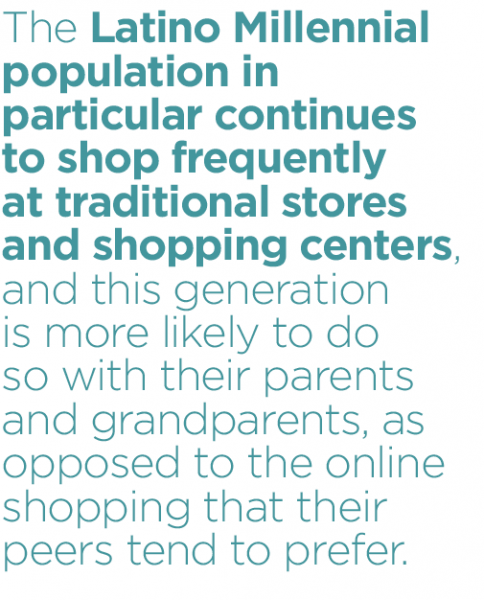Every 30 seconds one Hispanic turns 18 in the United States.
Currently, minorities make up almost half of all Millennials, and Latinos account for nearly 25 percent of this extremely influential group. With the Hispanic population growing at an exponential pace, the question for the commercial real estate industry is simple: “How can you have a Millennial strategy without asking yourself ‘What about Latinos?’”
The Hispanic baby boom in action
Today’s Hispanic baby boom has only just begun, and it will continue to bring tremendous economic growth, innovation and diversity throughout all business sectors in the United States. The number of minority-owned businesses in the U.S. has increased by 45.6 percent to 5.8 million over a five-year period—more than twice the national growth rate of all U.S. businesses, according to the U.S. Census Bureau.
As the Hispanic population continues to grow, Hispanic business leaders and service companies that serve this demographic will need diverse real estate representation and solutions, especially in urban markets. Urban markets have always been the epicenters that draw Millennials. These hubs provide the lifestyle this demographic is seeking, which combines housing, jobs and entertainment all in one place. Hispanic Millennials in particular are demanding business space and housing that are community-oriented, urban and modern; and they want diverse shopping options to suit their needs. As the industry works to meet the needs of this growing population, increasing diversity will be vital.
How can the commercial real estate industry respond to this growth?
The commercial real estate industry must recognize, embrace and understand that the Hispanic baby boom is now underway. Nearly half (45 percent) of the nation’s Hispanic population lives in the top 10 metropolitan areas, according to the 2010 American Community Survey (ACS) by the Pew Hispanic Center.
 For this reason, commercial real estate companies in markets such as Los Angeles, New York, Houston, Chicago, etc., will need to ensure that their teams are updated on demographic trends in the areas they serve in order to bring educated and creative solutions to clients in these areas.
For this reason, commercial real estate companies in markets such as Los Angeles, New York, Houston, Chicago, etc., will need to ensure that their teams are updated on demographic trends in the areas they serve in order to bring educated and creative solutions to clients in these areas.
Investing in a team that has different backgrounds, ethnicities and cultures will help commercial real estate firms to better understand the needs of the communities in which businesses and tenants are looking to grow. A diverse commercial real estate team will also enable companies to elevate idea sharing, giving firms inside knowledge from team members who have experience in these communities and cultures.
Multicultural Millennial strategy in action
In many cases, the retail sector has blazed the trail when it comes to multicultural Millennial strategy. The Latino Millennial population in particular continues to shop frequently at traditional stores and shopping centers, and this generation is more likely to do so with their parents and grandparents, as opposed to the online shopping that their peers tend to prefer.
Based on this activity, the Hispanic population is increasingly seeking retail options that fit its diverse and growing needs for services. Retail developers, owners, investors and tenants are working to meet that demand.
One example is Los Angeles-based Primestor, a retail developer that specializes in developing and managing retail centers in urban areas. This firm recognized the impact of the Hispanic baby boom early on, and continues to demonstrate its understanding of the need for urban revitalization that will have a direct and positive impact on the communities surrounding its retail properties.
Primestor’s strategy is centered around integrating community stakeholders and area residents in order to design and plan regional and neighborhood shopping centers that offer a tenant mix that is reflective of the needs of the community, and especially of today’s Millennials.
The key is for retail centers to achieve an atmosphere of openness—one that embraces difference and is welcoming to all. This is an important part of the Millennial mindset.
One way to create this sense of openness is to bring national retail chains into traditionally ethnic centers. Retailers such as Ross, TJ Maxx and Target have found success by opening locations in traditionally ethnic-focused retail properties.
Another strategy is to help smaller, ethnic-focused retailers expand into markets where Millennials are likely to discover and embrace them. Our team at Rosano Partners recently assisted two San Diego-based retailers, the Buffalo Spot and Los Primos, to grow with new locations in Greater Los Angeles. These two local restaurant chains already met the needs of local consumers seeking affordable/quality food options, and our team was able to identify new locations where each would thrive.
By supporting multicultural retail, commercial real estate professionals will increase the value of their current Millennial strategies, while also positioning themselves for future growth. As Millennials grow up and start families, they will continue to seek shopping destinations that are community-oriented and offer an eclectic mix of retail options that combine traditional brands with affordable local retailers.
Overall, all commercial real estate firms should be thinking about the Hispanic baby boom, and what it means for their business strategies now and in the future. A Millennial strategy without considering this important part of our population will prove to be lacking. Beyond that, as the U.S. continues to embrace multiculturalism, and as Millennials grow and change, our industry will find that diversity is the true key to success.
Ian Whitman is chief strategy and operations officer at Rosano Partners, a firm that specializes in retail and multifamily product, unique urban development opportunities, as well as placements of equity or debt.

